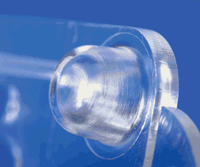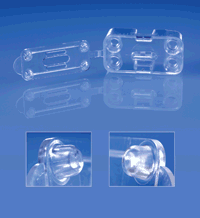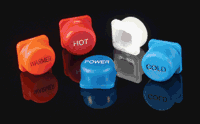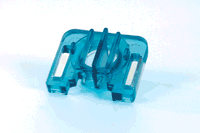Article
TOOLING: Solutions Start in the Mold

By: Michelle Maniscalco
LeVic Plastics overcomes challenges with its approach to tooling, including a creative way to vent using porous mold steel.
Ron Knight became an owner at molder/moldmaker LeVic Plastics in Grandview, MO in 1977, five years after it was founded. From the start, it has been a comprehensive operation offering not only molding and moldmaking, but also secondary tooling and operations, assembly, and engineering. Markets served include medical, aerospace, electronic, consumer, and industrial.
LeVic is a growing company today, despite the competition from offshore moldmaking and molding companies. Knight believes its growth is due to a strategic change in how the company approaches manufacturing: LeVic has adopted a solution-oriented approach. As a solution provider, it is open to, and regularly tests, different manufacturing processes. This view has paid off, both in retaining customers and acquiring new ones, especially those in important growth markets. It is able to supply its customers with a good-quality part out of a wide range of commodity and engineering resins.
In aggressively going after production challenges, LeVic has found a niche as a solution provider, a place where companies can bring their challenges for review. Ron is not afraid to try new ways to grow his business, which means educating existing and future customers in a changing, growing market to ensure better part quality at an affordable cost.
A new way to vent trapped gas
An example of turning its attention to solutions involves a change in the way LeVic vents some of its molds. According to Knight, certain mold geometries have one problem that plagues moldbuilders. “They trap gas in the most difficult places, and this gas must be released,” he says.
The most common and least expensive practice is to place inserts and/or vent pins in the mold. While this method works for a certain percentage of parts, it may be unacceptable to the finished surface on others because of insert or pin lines that are created.
LeVic solves this problem by placing Porcerax II (International Mold Steel, Florence, KY) inserts within some of its molds. This is a sintered, porous mold steel that is 25% air by volume. The pores allow trapped gases to escape directly through the steel. While this solution saves labor in moldbuilding, it is also the only way to produce certain medical and aerospace parts.
Knight comments on several benefits of using the porous inserts. “We are able to use several fill speeds or ram speeds for injection on our electric Toshiba machines, and the scrap rate dropped to almost zero. There are no weldlines or gas trapped in critical areas, and we also see a large increase in usable parts per hour due to zero surface imperfections.”
In one case, a seemingly impossible part was tooled successfully. “Medical parts often present the toughest molding challenges, as many times they require sealed surfaces,” says Knight. “This particular part is involved in bacterial analysis and can’t tolerate a weldline, no matter how small. In tests using K-Resin, we placed an insert inside the mold, and the result was a weldline. Then we placed Porcerax II in the mold with no resulting weldline.” Successful production of the part has brought additional medical business to LeVic.


This medical part (above) used in bacterial analysis could tolerate no weldlines. Traditional inserts left a weldline, as seen directly below the medical part, but Porcerax eliminated it (top).

LeVic molds buttons for the interiors of planes. They require mold inserts that often result in burns, trapped gas, or weldlines, which are considered unacceptable. LeVic uses Porcerax to solve the problem.

According to Knight, this medical part is molded with zero surface imperfections because the mold is vented with porous steel.